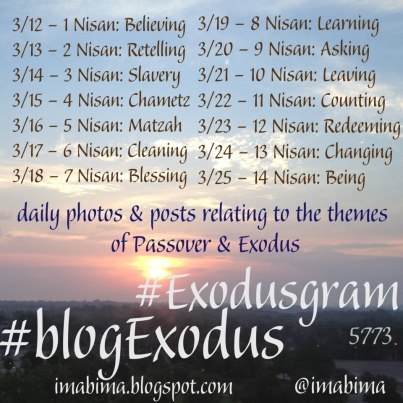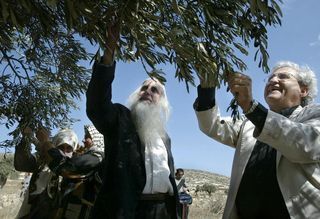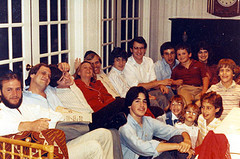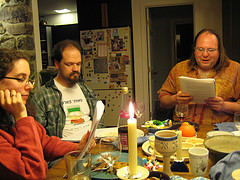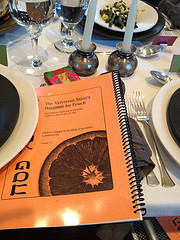Rachel Barenblat's Blog, page 197
March 12, 2013
1 Nisan: Believing
I believe in the Exodus.
I don't mean that I read it as history. I don't know that it ever "happened." But I believe that the Pesach story contains deep truths about liberation, and that when we retell it each year, we constitute our community.
When we understand ourselves as the people who were slaves to a Pharaoh in Egypt, the people who God brought out of constriction with a mighty hand and an outstretched arm, we remember that we have been in tight places and that if we have faith in something bigger than ourselves, we can find our way to freedom.
I believe that there is power in stories, and that this is one of the most powerful stories we know.
I believe that we are loved by an unending love. That when we find ourselves in places of constriction and our hearts cry out, God cries out with us.
I believe that surely as the moon is waxing, Pesach is coming, and that our celebration of Pesach can bring us blessing if we come to it with whole hearts.
This post is part of #blogExodus / #Exodusgram. Follow other posts on the path to Pesach via those hashtags!
March 10, 2013
Accompanying mourners, with gratitude
When I walk out of a mourner's home, having spent an hour or two listening to stories about the person who has died, I feel unspeakably lucky to be doing this work.
It's an incredible honor to be able to walk beside people in their mourning. To bear witness to their emotions and their memories.
Sometimes we look at old photographs or newspaper clippings. Sometimes one story leads to the next and suddenly everyone's talking over each other, eager to reminisce.
Sometimes the relationships were healthy and sweet, and the grief has the flavor of mourning something beautiful which has moved into memory.
Sometimes the relationships were painful or broken, and the grief has the flavor of mourning something which wasn't what it needed to be.
I try to take notes as unobtrusively as I can, asking questions -- if I need to -- to spark more stories. Bit by bit, anecdote by anecdote, a picture emerges.
Sometimes people ask me about Jewish ideas of the soul and the afterlife, wanting to know where (I think) their loved one is now, what comes next.
Sometimes people tell me stories about being present at the moment of death, the luminous quality that may accompany that transition into what we can't know.
Always when I make my farewells, even if I feel daunted by the task of writing a eulogy which will live up to their memories, I'm grateful to be able to try.
March 8, 2013
2 Nisan: Retelling (Pesach Sestina for #blogExodus)
The story's always ours to tell:
how Moses demanded that Pharaoh free
the Hebrews. We'd forgotten how to ask
for open air, for rest, for the taste
of all the possibilities of spring.
So God ordered: let My people go.
Pharaoh said: who exactly intends to go?
Maybe the men, sure, but don't tell
me you intend to try to spring
the women and children free.
Moses stammered. He knew the taste
of words locked tight, unable to ask.
This time the words were God's own task.
We know how the narrative will go:
Nile turned to blood, the taste
of locusts, darkness too thick to tell
one hand from the next. We made free
with lamb's blood on the lintels that spring
and Pharaoh relented. We got to spring
through the parted waters of the sea. We didn't ask
what it would mean to be set free.
All our leaders said was, it was time to go.
Bring your children on your back, tell
the women to bake in haste. Taste
and see that God is good! Now the taste
of that flatbread hyperlinks us with spring.
The full moon of Nisan, when we tell
our tale, when our children ask
why, on this night, do we all go
to seder? We recline, free
to take our time, to learn, to eat, free
to savor matzah and maror, the taste
of liberation in our mouths. I yearn to go
and sing all night until the sun springs
over the horizon and the sages ask
if it's time for the morning shema. Tell
me: what's it like to be free in spring?
Taste the sweetness of being able to ask.
Go and sit down. We've a story to tell.
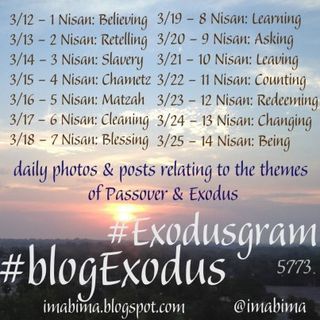 For my second contribution to blogExodus, I wrote a sestina. (If you dig sestinas, you might enjoy browsing the new sestina category here, which will bring you to all of the sestinas I've posted here over the years.)
For my second contribution to blogExodus, I wrote a sestina. (If you dig sestinas, you might enjoy browsing the new sestina category here, which will bring you to all of the sestinas I've posted here over the years.)
Today's theme is retelling, which is pretty much what Passover's about. In a certain way this retelling is central to Judaism all year round: we remember the Exodus daily (in our liturgy), weekly (in the Shabbat kiddush), and of course at Passover-time.
I enjoyed this chance to do some retelling in a new form.
For other people's contributions to these two weeks of Nisan pre-Pesach-blogging, keep an eye on the #blogExodus hashtag. Enjoy!
Tefillin and manicures
Me, in microcosm.
My mother always has beautiful nails. I'm not sure I've ever seen her without nail polish on. In recent years there are certain colors she favors -- a kind of creamy ivory, a deep maroon -- and I've come to expect one of those rather than anything else in the rainbow of available options. But her nails are always manicured. It's just part of being put-together. I don't remember my first manicure (though I remember the first one I had after my summer of backcountry camping when I was fourteen -- it felt positively sybaritic.) But getting my nails done is an ordinary, and sweet, part of my life.
The manicure I'm wearing now wasn't done by a professional. I painted my nails last night while my son splashed in the bathtub. He had chosen to color his bath water a brilliant turquoise blue (with a dissolving bath tablet which, amazingly enough, doesn't leave our bathtub stained when the water drains away.) He stomped and splashed, rocking his little duckies and boats, while I sat on the floor and painted my fingertips. Then he helped me blow on them to get them dry before I lifted him out of the tub.
I don't think anyone else in my immediate family wears tefillin. Scratch that: I'm pretty certain no one does. If I had to guess, I'd imagine that some of my Dallas cousins do, and possibly some of their sons. But I'd be surprised to discover any other women in my family who put on tefillin in the morning to pray. I became interested in tefillin the first time I went on a Jewish Renewal retreat at Elat Chayyim. Knowing that I'd been yearning for some, my dear friend David gave me my set of tefillin when I turned thirty.
In fairness: I don't always manage to lay tefillin. Life gets in the way. And, for that matter, I don't always manage to have my nails painted. But when I pause to put color on my fingertips, I feel like I'm treating myself to something special, and I remember again some of the many cherished ways in which I am my mother's daughter. And when I pause to lay tefillin, even if I only say one prayer before taking them back off again, I remember again some of the many cherished ways in which I am connected with God and with my tradition, with something bigger than myself.
Coming soon: #BlogExodus
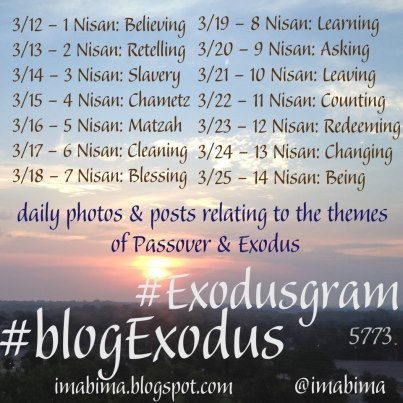
Ima Bima, a.k.a. Rabbi Phyllis Sommers, is orchestrating blogExodus again this year. Starting on the first of Nisan, the lunar month coming up next on the Jewish calendar (and the lunar month which contains Passover -- Pesach begins at full moon, on 15 Nisan), folks across the J-blogosphere will be blogging, tumblring, tweeting, pinning, instragramming, and...whatever-else-ing, on the themes listed above.
It's a really neat idea. A way of trying to ensure that the two weeks leading up to Pesach are a chance to focus ourselves on the spiritual work of getting ready for the Exodus, instead of (just) on the practical work of cleaning our houses and making our kitchens kosher-for-Pesach to whatever extent we each do (or don't do) that.
I can't promise that I'll manage to post on the blogExodus themes every day of the month, but I'm going to try to do at least a few. I'm psyched for Pesach and I love the idea of blogging on these themes along with everyone else who's participating. A kind of ad-hoc, self-organizing blogburst.
March 7, 2013
R' Menachem Froman: may his memory be a blessing
In the days since his death, Rabbi Menachem Froman -- may his memory be a blessing -- has been all over my blog reader, my twitter stream, and my Facebook feed. As my friends and colleagues have mourned his passing, sharing memories of studying with him, sipping tea with him, learning from him, I've been moved and surprised by what I've learned.
In the Jerusalem Post article Lessons from a man of peace, Yossi Klein Halevi describes Rav Menachem as a "man of paradox who helped found the settlement movement and continued to believe passionately in the right of Jews to live in all parts of the land of Israel, even as he came to promote a two-state solution and rapprochement between Judaism and Islam." That's a paradox, all right: a settler rabbi who believed in the Jewish people's God-given right to inhabit the whole land -- and who also worked toward the Palestinian dream of a Palestinian state, with full expectation that his home of Tekoa, now part of Gush Etzion in the West Bank, would be part of that state.
2002: Rabbi Froman picks olives with Palestinian women in the West Bank village of Aqraba, in protest against violence committed by Israeli settlers. (Image found here at Huffington Post -- the whole slideshow is quite remarkable.)
Rav Menachem's vision, Klein Halevi writes, was that "however improbably, it was religious Jews who were best positioned to make peace with the Palestinians and the Muslim world generally." The peace process as we have known it, he argued, has been largely driven by political actors who tend to be liberal or non-religious. In his mind, that's exactly why it hasn't yet succeeded. Klein Halevi continues:
He taught me that, in order to make peace with the Muslim world, one needs not only to honor Islam but to love it – cherish its fearless heart, the power of its surrender, the wisdom of its frank confrontation with human transience.
Once we went together to a mosque in Nusseirat, a refugee camp in Gaza. It was the time before the second intifada, when such adventures were still possible. We'd been invited by a community of Sufi mystics to join their zikr, the dance that combines chanting and breathing with vigorous movement. For nearly an hour we danced together with our Muslim fellow believers in God. "Allah!" Rav Menachem repeatedly cried out in devotion.
After the zikr, we sat with members of the community, and Rav Menachem explained why he had come here. Two thousand years ago, he said, my people sinned and were expelled by God from this land. But now God has brought us back, and I want to learn from my Muslim brothers who didn't leave here how to worship God in this land.
It was an extraordinary moment: A rabbi – from a West Bank settlement! – was telling Palestinian refugees that God had brought us back to this land. And they listened to him -- because he had come to learn from them, because he was speaking to them as one religious person to another, because he made no apology for Jewish indigenousness.
The mention of dancing / chanting zhikr with Sufis puts me, of course, in mind of the story of Reb Zalman Among the Sufis of Hebron, to which I have linked many times before.
The JPost isn't the only Israeli paper remembering Rabbi Froman. In Ha'aretz, Gershom Baskin offers Menachem Froman, the settler rabbi who wanted to be a Palestinian citizen, a personal letter of remembrance to Rav Menachem. Baskin notes that he himself is not religious and does not believe in God, but that Menachem never seemed to mind. He writes:
The last time we met, about one month ago, was when we together went to speak to President Mahmoud Abbas. You were weak and in pain, but the meeting and working for peace gave you strength. And you spoke for about one hour. And President Abbas listened and responded. He had admiration in his eyes for you and appreciation for your love of humanity and your dream to see peace before you left this world. You told Abu Mazen that you look forward to being a citizen of the State of Palestine, living in your home in Tekoa. Abu Mazen responded that he looked forward to giving you a Palestinian passport.
In the video embedded below -- seven minutes -- he points out that God tells us to love our neighbor, and that the Palestinians are his neighbor; therefore it is his religious duty to love the Palestinians. (If you can't see the embed, you can go to the video at YouTube: The Challenges of Rabbi Menachem Froman.)
(I also recommend the short video Rabbi Froman Goes to Qusra -- in 2011 he made a sympathy visit to Qusra, where right-wing settlers had vandalized
the mosque the night before. He begins his remarks with a fluid Arabic bismillah as well as a fervent prayer of Allah hu akbar; his further remarks, in Hebrew, are translated on the spot into Arabic. The video, in-progress material from the documentary A Third Way: settlers and Palestinians as neighbors, is subtitled in English. If you want to contribute toward the finishing of A Third Way, you can do so here.)
I'm humbled to learn about Rav Menachem and his work. He managed to
bridge positions typically described as left-wing (he advocated a
two-state solution and met regularly with leaders of the PA, including
the late Sheikh Yassin of Hamas) and positions typically described as
right-wing (he believed in the God-given right of the Jewish people to
live in all parts of the land of Israel, and strongly opposed the
uprooting of settlements in Gaza and/or the West Bank.) I wish that he
had lived to see the peace for which he so ardently yearned. May that
peace come speedily and soon.
For more:
Rav Froman's Funeral, Elisheva Goldberg, The Daily Beast, March 2013. "Rav Froman endorsed Obama
for president and, on Election Day, he went to pray for his victory at
the Cave of the Patriarchs in Hebron. A symbolic act that summarized his
interesting, complex, and, yes, privileged politics. He deeply believed
that Islam is a religion of peace, and he was outspoken about his
desire to obtain citizenship in a future Palestinian state. Yet all of
the elements of his philosophy were manifest in Tekoa, a settlement
surrounded by Palestinian villages that, however you cut it, is still an
obstacle to a two-state solution and on unequal footing in countless
ways with the very neighbors to whom Froman was so friendly."
Settler rabbi fights rightist attacks with neighborly solidarity, Harvey Stein & Brad Rothschild, +972, October 2011. "Rabbi Menachem Froman, the 'settler rabbi for peace,' from the Tekoa settlement, sometimes
comes to the rescue after these price tag operations, especially ones
aimed against religious symbols, like mosques. Froman has been going
against the grain for over 20 years: he had a long-term friendship with
Yassir Arafat, and visited the wheelchair-bound spiritual founder of
Hamas, Sheikh Yassin, in Gaza (before Yassin was terminated by an
Israeli Air Force missile in 2004). More recently, he has organized
contingents of settlers, armed with new Korans, to visit the villages
inflamed by their mosques being burned or defaced."
Thousands mourn beloved, controversial West Bank rabbi, Matti Friedman and Ellie Leshem, The Times of Israel, March 2013. "His vision was not
without its contradictions — he sought an equal partnership with
Palestinians while participating in a settlement enterprise predicated
on their disenfranchisement under military rule — and his
ideas drew widespread interest but few dedicated followers. His
personality was such, however, that few doubted the honesty of his
intentions, and many were attracted by his engaging and offbeat nature,
by his willingness to flout criticism and pursue an entirely original
path, and by the intensity of his belief."
March 6, 2013
Parenthood and Pesach
Pesach is my favorite holiday. This has been true for as long as I can remember. I have always looked forward eagerly to seder, the way one looks forward to a birthday party or a vacation. When I was a kid, I loved seeing my aunts and uncles and cousins each year at this season. I loved singing the Mah Nishtanah (a.k.a. The Four Questions), I loved hunting for the afikoman with my cousins, I loved the familiar litany of songs and prayers, I loved getting to stay up late. I loved seder. (I loved getting an afikoman gift once the hidden matzah had been found.) I even loved the fact that our second-night seder was exactly the same as the first night (except for the addition of the counting of the Omer) -- children love repetition, so the fact that it was an exact reprise made it even better.
Cousins at seder, circa 1983. I'm one of the little ones.
Now my son is three and I'm bumping up hard against the question of how I can help him love Pesach the way that I do. I know I can't give him the seder experiences of my childhood. No matter how hard I try, I can't give him my memories! I had over a dozen cousins on my dad's side of the family, and Pesach was a family reunion each year. To this day, I associate these prayers and these songs and these melodies with those cousins, and that gives them an extra patina of sweetness. But that's not my son's context. He won't grow up with memories of flying to Dallas, staying at the hotel with the glassed-in elevator, going to Aunt Sylvia and Uncle Bill's for seder year after year. So what will his seder memories be, as he grows up? I've wondered this each year since he was born, but this is the first year that he's old enough to be becoming conscious of holidays -- Halloween, his birthday, etc -- so this year the question takes on added urgency.
Seder with friends, a few years before we became parents.
We never did a children-oriented seder when I was a kid. Or at least, that's not what I remember. In my memory our seder was the same year after year, the texts and practices and songs geared toward the grown-ups, with the notable exception of the Mah Nishtanah which was sung by each child in turn. Once I was old enough to read the words, I sang the Four Questions, too, and looked forward to showing off a little. (Yeah, I was that kid.) But after that I mostly remember running around the house looking for the afikoman, making sure to be away from the table during the gefilte fish course and back in time for matzah ball soup.
In talking with friends and colleagues who have young children, I'm hearing from a lot of people who do seders geared toward the youngest people present. I wonder what that would be like. Should we begin the evening building pyramids with the giant cardboard bricks we keep under the stairs, and have someone play Pharaoh who Will Not Let Us Go, and pelt the Pharaoh with stuffed frogs until he agrees to let us walk through a sea of blankets to freedom? Would that teach our son the heart of the story we retell each year, and in the retelling constitute ourselves again as a community? Would we then save the poems and prayers, the psalms and responsive readings, for after he's left the table to play in the living room with toys?
Many of the customs of the seder are designed to provoke the children at the table to ask why we're behaving so differently on this night than we do on all other nights. There's the custom of placing pillows on the chairs so that everyone can symbolically "recline," as free men did at banquets in the Ancient Near East. The custom of putting a series of strange symbolic foods on a ceremonial plate in the middle of the table -- from the roasted bone and the haroset to, these days, the olive and the orange -- and pouring an extra glass of wine for an invisible prophet who we never see. But I don't know whether these things will seem strange enough to provoke his curiosity.
At my sister's house last year for first-night seder.
I don't know yet exactly what shape our first-night seder will take, this year. (The second night, we'll be going to my shul for a community seder, which our son will attend until he runs out of patience or wakefulness, at which time his dad will bring him home.) But I'm keenly aware, as a rabbi and as a parent, that I want to find a way to open up this holiday's traditions for my son in all of their beauty. And, of course, I know that he may not even be willing to taste the matzah balls or the haroset whose flavors and textures are so evocative for me! And since right now he resists most lullabies and new songs, he may not want, this year, to learn the songs which speak to my heart.
I guess this is one more place where we'll do the best we can and hope that the love comes through. (But if you've navigated this question, or if you're navigating it now, I'd love to hear about your solutions and what turned out to work for you.)
March 4, 2013
Merle Feld on Waiting to Unfold
I've just gotten another quote for the back of Waiting to Unfold, the poetry collection I'm blessed to have coming out later this spring from Phoenicia. I suspect the quote will be abbreviated for the book cover, but I wanted to share it here in full, because it's just so gracious and so lovely.
In these remarkable poems Rachel Barenblat traverses the world
of first-time parenthood with insight, generosity, rare courage. She shares first innocent awe, then unexpected
darkness as a winter of the soul claims squatter's rights in the nursery, and
finally, aching, yearning, growing toward hope, a relearning of holy presence in
small things. We ascend and plummet on
the rollercoaster with her, terror in the pit of the
stomach, knuckles white, and then – unparalleled joy. "Daily I expand how much I can love/ your
toes, your cough, your raised eyebrow… Each day your glee polishes my rough
edges/ and I shine…" New parents will be
astonished that someone has found words for their deepest secrets, parents long
past these early months will gratefully nod – yes, I remember, this is true.
-- Merle Feld, author of A Spiritual Life: Exploring the Heart and Jewish Tradition (SUNY Press, revised 2007) and Finding Words (URJ Press 2011)
I'm delighted that Merle -- whose work I have long admired -- has such kind things to say about my forthcoming book. Thank you, Merle! I'm particularly moved to hear Merle say that "new parents will be astonished that someone has found words for their deepest secrets" -- that's exactly how I felt when I was reading Heid E. Erdrich's The Mother's Tongue (specifically the series of poems called "Milk Sour") when I was new to motherhood and was struggling to name my welter of emotions.
I can't wait to be able to share this collection with all of y'all. Stay tuned for more.
March 1, 2013
R' Irwin Kula on the Rabbi in the Public Square
I want to offer one more post about the Rabbis Without Borders fellows meeting. On the second day of our gathering, Rabbi Irwin Kula offered a session called Rabbi in the Public Square. We'd been talking a lot about how we do our work within this visible networked world of social media, and what it's like to feel so visible (on Facebook or Twitter or YouTube), and he noted that "Religious people have long known that we're always seen. The Kadosh Baruch Hu [Holy Blessed One] is always able to see us." I liked that. (And it reminded me of the Sufi story about the sheikh who gave birds to his disciples, which Reb Zalman told at Shavuot a few years ago.)
He continued, "If you're going to have more transparency than ever, you need a God who is more forgiving than you ever imagined." I liked that point a lot too. And I resonate with his argument that at this moment in time, "we don't have alternative narratives, or languages, which are powerful enough to even have the conversation [about God or faith or what we really believe] in public culture."
He noted wryly that he thinks one teaches best to modulate one's own anxieties, and that whatever is driving one's anxieties will be the source of some of one's deepest Torah. The question which arises for him is, "do we have wisdom and practice that can add significant value to the concerns and cares and anxieties and desires and yearnings and dreams and nightmares that people have in their lives?"
As a New Yorker who was in the city when 9/11 happened, he's still dealing with the reverberations of that trauma. (I've linked several times over the years to his setting of the 9/11 voicemails in Eikha trope, which continues to move me both as a way of engaging with 9/11 and as an alternative pathway into Tisha b'Av.) He noticed that in the aftermath of the attack, only one rabbi appeared on national television; for the most part, rabbinic response to that national tragedy was invisible in the public square. And, he noted, the dominant narrative coming out of the mainstream Jewish community after 9/11 was, "now every American knows what it feels like to be" -- and every one of us in the room was able to chime in, because we had heard it too -- "an Israeli."
To be sure, that narrative about 9/11 does contain partial truth. Yes, there are ways in which that attack on our soil replicated for Americans some of the kind of uncertainty which for Israelis has become tragically commonplace. But, Rabbi Kula asked us, how does that narrative help? And what message is implied when a 3,000-year-old people which has been through churban (destruction), a people which "has in its repertoire insights about vulnerability and powerlessness," chooses to articulate that particular narrative in the public eye? The real question for him, he said, is how do we use Torah in our work in the world. Do we have the skills, the capacity, the methods, the pedagogies to bring Torah to bear on today's problems?
What wisdom do we have to bring to bear on any issues which are concerns of people today, beyond Jewish identity issues? Can the Torah add value, or does it turn out to be two types of things, either our political positions dressed up in religious garb or, on personal meaning issues, our psychological predispositions dressed up in Torah?
Do we really need Torah for more than prooftexting, cheerleading, apologetics, argument from authority? Though fewer and fewer American Jews experience Torah as having authority, so garbing our political opinions and our psychological presidpositions in Torah in a sense undermines Torah [for a lot of people].
We [Jews/rabbis] have voice [in America today]. What's the content we're offering, now that we have voice? If it turns out that all we do is use the Torah to legitimize, to affirm, to anchor, to root our existing takes, I think we're going to have increasing difficulty in this next round of Jewish life.
Rabbi Kula asked us to ponder the question of: how many times has Torah changed our positions on a political issue? (In other words: to what extent does Torah shape our politics, and to what extent do our existing political stances inform how we read Torah?)
We moved then to studying Talmud (Eruvin13b). Our text for the morning centered around Rabbi Meir, whose name comes from the root which means light. He was so brilliant that no one else could follow his wisdom and insights. He illuminated things, discerned truths and new dimensions, expanded the horizon. He also destabilized and confused things. He was able to see beyond binaries. Meir (the Talmud tells us) could see the unclean in the clean, and vice versa. (Just so, one of my colleagues noted, he could see the holiness / purity even in his teacher Elisha ben Abuya, who had been ruled outside the pale by virtue of his apostasy. That's a story with which we were all intimately familiar, though I at least had never considered how Meir's ability to see through binaries is precisely what allows him to remain connected to his teacher after his teacher was placed in cherem.)
And what about us, Rabbi Kula asked. Can we locate the small truth even in the opinion with which we strongly disagree? Can we follow Rabbi Meir's example and strive to live in the logical impossibility of knowing that each thing contains its opposite, and that there is truth even in the positions with which we disagree? (For instance: that we live in the postmodern era of "God is dead," and that God continues to animate everything that is; we live in exile from God's presence, and we live in constant communion with that presence. These contradictory things are always both true.) "Enlightenment means being able to acknowledge the rightness of the other side," Rabbi Kula said. "That's how we reach understanding. The best shot you have of accessing the deepest truth in this moment is accessing the other person's argument."
How many of us who favor gun control can truly put ourselves in the shoes of someone who believes the government wants to take away our right to bear arms? How many of us who support gay marriage can truly see the nitzotz elohut, the spark of godliness, in the argument against what we passionately believe and in the people who make that argument? (And vice versa, and ditto for other major social issues of our moment -- if these don't speak to you, think of one which does.) I don't want to make the facile claim that this is easy. On the contrary, this is incredibly difficult spiritual work. But if we, as today's rabbis, aren't up to taking on this work, then who will? As Hillel had it, if not us, then who, and if not now, then when?
The psychospiritual drama of this passage from Talmud, suggested Rabbi Kula, is the tool we need to bring to bear on the polarized issues in our culture. We need to simultaneously be masters of stability, and masters of instability. To live in the stability which is real even though the world around us is destablized; to live in instability even though the world around us may appear to be solid. One of the alternate names the Talmud gives to Rabbi Meir is Nechemia, which comes from the same root as nichum, comfort. Emulating R' Meir, living in the stability/instability and embracing our own deepest truths even as we acknowledge that there's truth in the positions with which we disagree, is how we become able to offer real pastoral comfort.
"When you really can understand this, you can have a teacher like Elisha ben Abuya and stay connected," Rabbi Kula told us. When we're really rooted in this ability to embrace opposites, to see the truth in the other side, to live in the impossibility of knowing that the world is stable and unstable all at once, of recognizing that "I am dust and ashes" and "for my sake the world was created" always coexist (see Balancing the scales), then we'll be able to engage really broadly, even with those whom others might find dangerous or heretical, even with people who are different from us, without losing our own integrity or integration.
It was a fabulous session. I know I'll be reflecting on it for a long time to come.
February 28, 2013
My first video vort: on the bedtime shema
One of the things we did together at the second meeting of my Rabbis Without Borders fellows cohort was work together, in small groups, on making video vorts. "Vort" is the Yiddish word for "word;" a vort, in this context, is a word of Torah, a wee spoken-word teaching.
I haven't experimented with video. The other social media we'd been talking about -- twitter, Facebook, etc -- are pretty solidly in my wheelhouse, but video is a new one for me. And it turned out to be fun. Maybe because we were doing it together, as friends and colleagues, and all of us were stretching ourselves in one way or another.
Several of us showed our videos to our cohort, and talked about them -- who we thought the audience of each one was meant to be, what worked and what we could do better next time, etc. Showing my video to my cohort emboldened me, so I decided to share it here, too, even though it isn't perfect.
Embedded below: Two minutes of me talking about one of my favorite mitzvot, the bedtime shema. I describe the mitzvah, explain how it manifests in my life, and talk about how I know when it's working.
If you can't see the embedded video, above, you can watch the video here at YouTube. Let me know what you think: is this a useful way for me to share occasional very short teachings here?
Rachel Barenblat's Blog
- Rachel Barenblat's profile
- 6 followers


